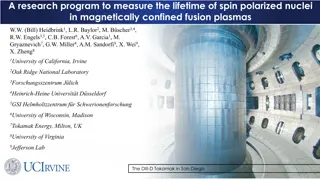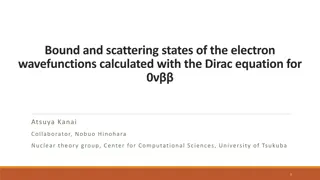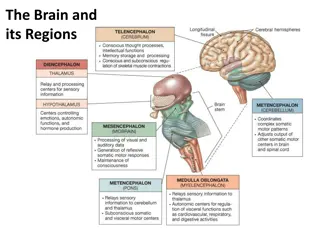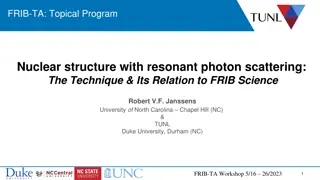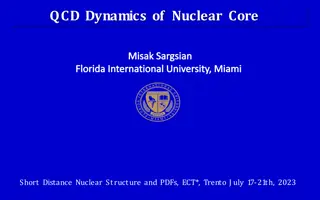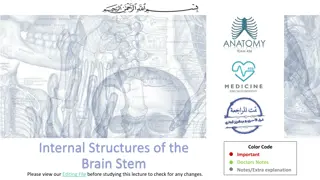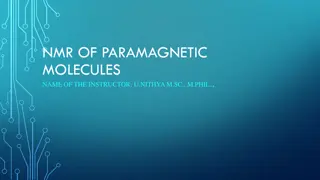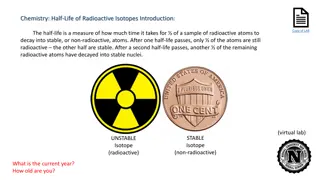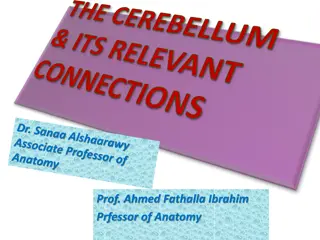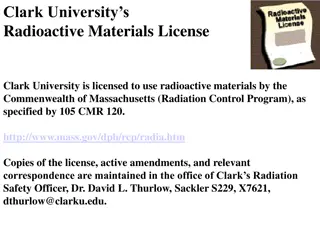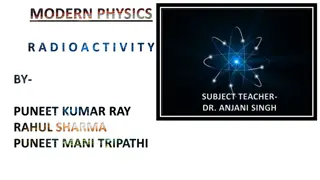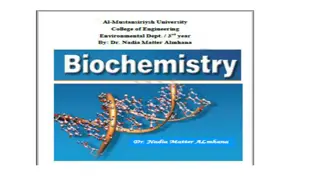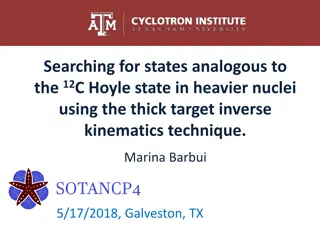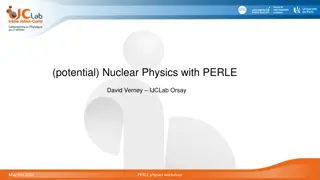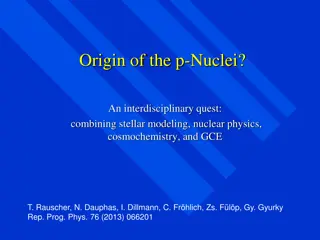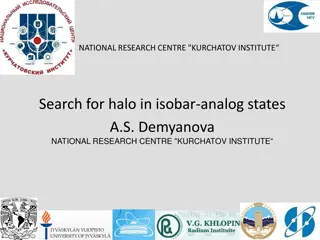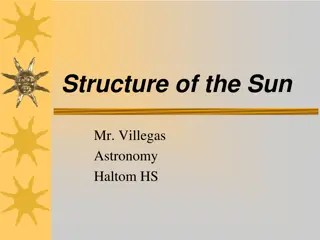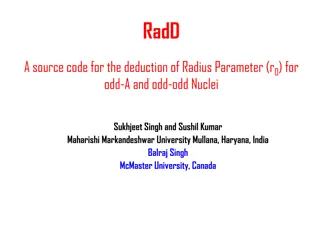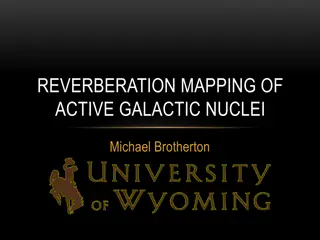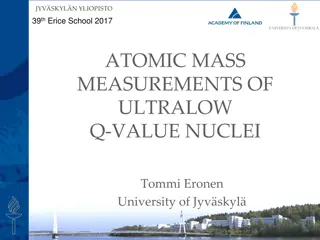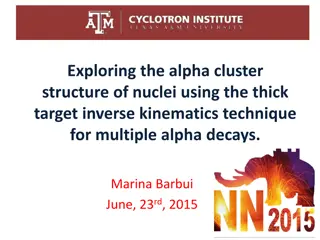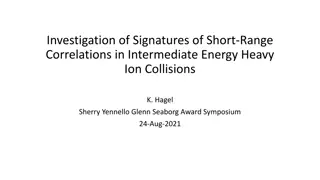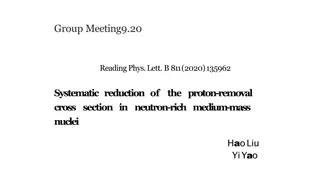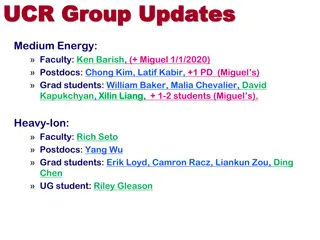Research Program on Spin Polarized Nuclei in Fusion Plasmas
Examination of spin polarized fuel in fusion plasmas to enhance energy production efficiency. Planned experiments aim to measure the lifetime of polarized nuclei for optimized fusion reactions. Key aspects include depolarization mechanisms, neutral beam heating, and fueling techniques with pellets.
1 views • 36 slides
Advancing Nuclear Physics with Heavy Ion Storage Rings
Explore the world of rare isotopes and exotic ions through the use of Heavy Ion Storage Rings, enabling precision measurements, production of unstable nuclei, and beam-target interactions for studying nuclear processes and astrophysical relevance. Supported by the U.S. Department of Energy, this tec
5 views • 9 slides
Understanding AGN Jet Production Efficiency: Insights from Spin and Magnetic Flux
A fundamental question in astrophysics is how efficiently active galactic nuclei (AGN) produce jets. Black hole spin and magnetic flux play crucial roles in determining the jet production efficiency. High-spin values and large magnetic flux threading are essential for generating high-efficiency jets
2 views • 22 slides
Understanding Radioactive Decay and Nuclear Radiation
Radioactive decay is the process in which unstable atomic nuclei emit charged particles and energy, transforming into different elements. This process involves the emission of alpha particles, beta particles, and gamma rays. Alpha particles consist of two protons and two neutrons, beta particles are
4 views • 31 slides
Possible Analog States of the Hoyle State in Heavier Nuclei
Research conducted at the National Research Centre, Kurchatov Institute, explores possible analogs of the Hoyle state in heavier 4N nuclei, focusing on the 7.65 MeV 0+2 state in 12C (Hoyle state). The study reveals insights into the structure and characteristics of the Hoyle state, crucial for under
0 views • 12 slides
Quantum Physics Research on Electron Wavefunctions and Double-Beta Decay
Researchers at the University of Tsukuba study electron wavefunctions using the Dirac equation and analyze double-beta decay in nuclei. The calculation of phase space factors, nuclear matrix elements, and bound and scattering states of electrons are explored to understand fundamental particles and t
0 views • 12 slides
Explore the Fascinating World of the Brain and its Functions
Delve into the intricate structures and functions of the brain, from its regions to the cerebral lobes. Learn about the roles of the left and right hemispheres, essential sensory and motor areas, and the cerebral nuclei. Discover how the brain enables us to be conscious, control movements, and proce
4 views • 27 slides
Understanding Hyperfine Interactions in Atomic Physics
Hyperfine interactions play a crucial role in atomic physics, leading to small energy shifts and splitting of degenerate levels in atoms and molecules. These interactions involve the electromagnetic multipole interactions between the nucleus and electron clouds, resulting in the splitting of energy
13 views • 154 slides
Pascal's Rule in NMR Spectroscopy ( n+1 )
Pascal's Rule in NMR spectroscopy, also known as the (N+1) rule, is an empirical rule used to predict the multiplicity and splitting pattern of peaks in 1H and 13C NMR spectra. It states that if a nucleus is coupled to N number of equivalent nuclei, the multiplicity of the peak is N+1. The rule help
1 views • 30 slides
Nuclear Structure Investigations with Resonant Photon Scattering at FRIB-TA Workshop
Explore nuclear structure using resonant photon scattering at the FRIB-TA Workshop. The High Intensity Gamma-ray Source facility enables research on photonuclear reactions, spin and parity determinations, and selective investigation of nuclear states. Learn about the technique's potential impact on
2 views • 33 slides
Understanding Nuclear Structure and Forces in Physical Science
Explore the fascinating world of nuclear structure and reactions within atoms, delving into concepts such as nuclear force, binding energy, mass defect, and nuclear stability. Discover the intricacies of nucleons, neutron stars, and the Band of Stability, along with magic numbers that contribute to
6 views • 9 slides
Insights into Nuclear Core Dynamics and Structure
Exploring the dynamics of nuclear cores, this research delves into the intricacies of probing the NN repulsive core, modern NN potentials, and field theories of nucleons and mesons. The study encompasses the isospin dependence, non-nucleonic components, hidden color, and gluons within the nucleus, s
1 views • 63 slides
Pollen Grain Development
The process of pollen grain development and formation of the male gamete involves crucial stages such as the presence of diploid microspore mother cells in the stamen, meiosis resulting in the formation of four haploid cells and tetrads, mitosis leading to the development of two haploid nuclei in ea
0 views • 6 slides
Understanding Internal Structures of the Brain Stem
Explore the intricate details of the brain stem, focusing on the medulla oblongata, pons, midbrain, and the reticular formation. Learn about the distinct components at different levels, such as sensory nuclei, motor decussation, and pathways critical for various functions. Dive into the complexities
1 views • 26 slides
Understanding Radioactivity and its Particles in Radiochemistry
Radioactivity involves the spontaneous decay of unstable atomic nuclei, releasing radiation in the form of alpha particles, beta particles, and gamma rays. Alpha particles are heavy and have low penetration, beta particles are light and faster, while gamma rays are high-energy waves with great penet
0 views • 20 slides
Understanding NMR Spectroscopy of Paramagnetic Molecules
NMR spectroscopy of paramagnetic molecules is influenced by the presence of unpaired electrons, leading to broadened spectra and complex coupling mechanisms. Quadrupolar nuclei, with spins greater than 1/2, play a significant role in the relaxation and splitting of NMR signals. The interaction betwe
0 views • 19 slides
Exploring Radioactive Decay: A Half-Life Lab Simulation
Explore the concept of radioactive decay through a virtual lab simulation involving strontium-90 (Sr-90) and yttrium-90 (Y-90) isotopes. Witness the decay process over multiple half-lives as unstable atoms transform into stable nuclei. Dive into the intricacies of half-life measurements and the vast
0 views • 10 slides
Understanding the Anatomy of the Cerebellum: External and Internal Features
Explore the intricate details of the cerebellum with Prof. Ahmed Fathalla Ibrahim. Learn about the external features, anatomical subdivisions, internal structure, and nuclei of the cerebellum. Understand its origin, position in the brainstem, and connections to the brainstem. Gain insights into the
1 views • 26 slides
Understanding Synchytrium: Causes and Symptoms in Potatoes
Synchytrium is an obligate parasite causing black wart disease in potatoes. It affects underground parts, leading to cauliflower-like outgrowths on tubers. The fungus exhibits a unicellular structure and releases uniflagellate zoospores for asexual reproduction. Germination of prosorus results in th
0 views • 13 slides
Understanding Radioactivity: A Comprehensive Overview
Radioactivity is the spontaneous decay of unstable atomic nuclei, emitting alpha, beta, or gamma rays. This phenomenon is regulated by Massachusetts laws, with institutions like Clark University licensed for responsible use. Alpha decay involves emission of helium nuclei, while beta decay releases e
0 views • 39 slides
Understanding Radioactivity in Modern Physics
Radioactivity is the spontaneous emission of radiation by unstable atomic nuclei, seeking a more stable configuration. It can be measured using the becquerel as the SI unit, with factors determining nuclear stability being neutron/proton ratio and number of nucleons. The Law of Radioactive Decay exp
0 views • 18 slides
Neuroanatomy Brainstem Slides Self-Assessment Study Guide
Explore detailed slides of brainstem structures for self-assessment and study purposes. Identify key areas such as spinal cord, pyramidal decussation, sensory decussation, and vagal nuclei with visual aids. Enhance your knowledge of neuroanatomy with labeled diagrams and information on various tract
0 views • 13 slides
Understanding the Molecular Composition of Living Cells
Living cells are primarily composed of hydrogen, oxygen, nitrogen, carbon, phosphorus, and sulfur, which form the basis of organic biomolecules. Cells have common features such as cytoplasm, cell membranes, and nuclei. Different types of cells exist, ranging from eukaryotic with organized nuclei to
0 views • 9 slides
Exploring States Analogous to 12C Hoyle State in Heavy Nuclei Using Inverse Kinematics
The study discusses the search for states similar to the 12C Hoyle state in heavier nuclei through the thick target inverse kinematics technique. It explores alpha clustering in nuclei, the thick target inverse kinematics method, events with alpha multiplicities, and more experimental details relate
0 views • 19 slides
Exploring Nuclear Physics with Electromagnetic Probes
Delve into the intricate realm of nuclear physics through the utilization of electromagnetic probes, showcasing advancements in ion manipulation, mass measurements, laser spectroscopy, and more. Uncover the internal structure of nuclei and the nuances of electron scattering, offering a glimpse into
1 views • 18 slides
Understanding the Origins of p-Nuclei: An Interdisciplinary Exploration
The study delves into the origin of p-nuclei, which are not produced by s- and r-processes. It discusses their scarcity, involvement in stellar processes, and potential production mechanisms like the p-process. Various scenarios and challenges in explaining the abundance of p-nuclei are also elabora
0 views • 35 slides
Mechanism of Low-Energy Nuclear Reactions in Low-Temperature Plasma
This work discusses nuclear-chemical processes underlying low-energy nuclear reactions in low-temperature plasma environments, focusing on the initiation of artificial radioactivity in metal cathodes under protium- and deuterium-containing nonequilibrium plasma conditions. The role of electrons with
4 views • 6 slides
Exploring Nucleonic Halos in Isobar-Analog States at Kurchatov Institute
The research at Kurchatov Institute focuses on investigating nucleonic halos in isobar-analog states (IASs) of nuclei, aiming to understand the structure and properties of exotic nuclei with neutron halos. Neutron halos, characterized by enlarged radii of valence neutrons, have been observed in both
0 views • 15 slides
Understanding the Structure and Energy Production of the Sun
Explore the composition and nuclear fusion processes of the Sun through spectroscopy and the generation of energy via nuclear fusion using hydrogen nuclei. Discover how hydrogen and helium make up the majority of the Sun's mass, with multiple elements present in trace amounts. Learn about the steps
0 views • 34 slides
Code Assignment for Deduction of Radius Parameter (r0) in Odd-A and Odd-Odd Nuclei
This code assignment focuses on deducing the radius parameter (r0) for Odd-A and Odd-Odd nuclei by utilizing even-even radii data from 1998Ak04 input. Developed by Sukhjeet Singh and Balraj Singh, the code utilizes a specific deduction procedure to calculate radius parameters for nuclei falling with
1 views • 12 slides
Significance of Pear-Shaped Nuclei in Atomic Physics
Causes of deformation in atomic nuclei, leading to pear-shaped structures, are explored with examples such as 224Ra and 220Ra. Measurement of Barium isotopes using advanced techniques sheds light on the spatial asymmetry of nuclei. The significance of pear-shaped nuclei in explaining CP-symmetry bre
0 views • 7 slides
Understanding Active Galactic Nuclei and Black Hole Mass Measurements
Exploring active galactic nuclei (AGN) through reverberation mapping techniques to measure black hole masses, observing AGN schematics, ultraviolet-optical AGN spectra, and methods for measuring masses in space. Delve into the current understanding of AGN fields, the future prospects, and ongoing re
0 views • 30 slides
Atomic Mass Measurements of Ultralow Q-Value Nuclei at University of Jyvaskyla
Explore the cutting-edge research on atomic mass measurements of ultralow Q-value nuclei conducted at the University of Jyvaskyla. This research delves into various techniques such as Penning trap atomic mass spectroscopy and PI-ICR to study Q-values for reactions and neutrino studies. The investiga
0 views • 29 slides
Exploring Alpha Cluster Structure in Nuclei Using Thick Target Inverse Kinematics Technique
Exploring the alpha cluster structure of nuclei through the thick target inverse kinematics technique for multiple alpha decays. This study investigates alpha clustering in nuclei, potential alpha condensates, and the application of the inverse kinematics technique in detecting multiple alpha emissi
0 views • 14 slides
Development of Female Gamete and Embryo Sac in Plant Reproduction
In plant reproduction, the formation of female gametes involves meiosis in cells of the carpel sac, leading to the development of the embryo sac or megaspore. Meiosis results in four haploid cells, of which three degenerate, and one survives. This surviving cell undergoes multiple rounds of mitosis,
0 views • 7 slides
Investigation of Short-Range Correlations in Heavy Ion Collisions
Short-range correlations in nuclei play a crucial role in understanding the properties of nuclear wave functions and the transition from baryonic to quark-gluon degrees of freedom. Early theoretical work emphasized the importance of short-range correlations, particularly in modeling the nucleon spec
0 views • 17 slides
Auditory Pathway in the Brain: Nuclei, Pathways, and Connections
Explore the anatomy of the 8th cranial nerves, specifically the auditory pathway in the brain. Learn about the nuclei related to vestibular and cochlear nerves, their types and locations, along with descriptions of the vestibular and auditory pathways. Discover the primary auditory cortex, medial ge
0 views • 23 slides
Compilation and Evaluation of Experimental Data for Nuclei in Z=2-28 Region
Completed compilation and evaluation of experimental Pn and half-lives for nuclei in the Z=2-28 region, led by Balraj Singh at McMaster University. The work involved preparing lists of neutron-rich nuclides, identifying potential emitters, analyzing available experimental data for 1n, 2n, 3n, and 4n
0 views • 20 slides
Systematic Reduction of Proton-Removal Cross Section in Neutron-Rich Medium-Mass Nuclei
Single-nucleon knock-out reactions in neutron-rich medium-mass nuclei were studied to investigate the reduction of proton-removal cross section. Short-range correlated nucleon pairs, especially protons, were found to impact the probability of single-proton removal processes. Experimental measurement
0 views • 8 slides
Updates on UCR Group Medium Energy and STAR Forward Upgrade
UCR Group has updates on faculty, postdocs, grad students, and ongoing projects in Medium Energy and Heavy-Ion domains. The STAR Forward Upgrade focuses on Calorimeter System R&D for EIC Detector. TMDs research at STAR is advancing with data on higher x values and Q2 at 100 GeV2. Initial State of Nu
0 views • 4 slides
